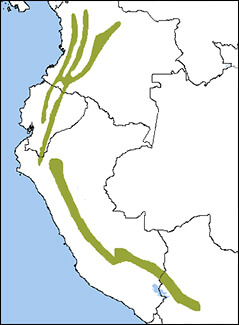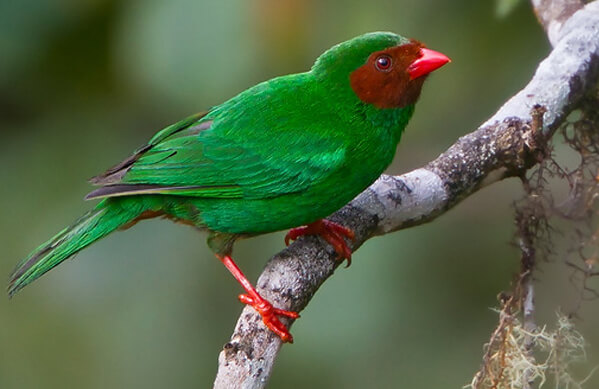 The aptly named Grass-green Tanager is the only member of its genus, Chloronis, a Greek word derived from khloros (green) and ornis (bird). In Spanish its common name is Tangara Lorito, "little parrot tanager." Whatever the language, this bird of the Andes is an unmistakable sight: an intense green with chestnut mask and undertail accented by bright red legs, feet, and bill.
The aptly named Grass-green Tanager is the only member of its genus, Chloronis, a Greek word derived from khloros (green) and ornis (bird). In Spanish its common name is Tangara Lorito, "little parrot tanager." Whatever the language, this bird of the Andes is an unmistakable sight: an intense green with chestnut mask and undertail accented by bright red legs, feet, and bill.
Although not endemic or endangered like the Cherry-throated Tanager, the Grass-green Tanager is still vulnerable to habitat loss caused by land clearing for farming, grazing, logging, and human settlement.
Fruit Masher
Grass-green Tanagers can often be found in pairs or small groups of three to six individuals. Like other South American tanagers, including Gilt-edged Tanager and Green-headed Tanager, it also joins mixed-species feeding flocks, moving through the low- to mid-story of the forest in search of fruit and insects.
Sign up for ABC's eNews to learn how you can help protect birds
The Grass-green Tanager also shares with other tanagers the behavior of plucking berries while perching or clinging, rather than on the wing. The birds mash larger or tough-skinned fruits with their bills to get at the pulp inside, discarding the skin.
Although not a long-distance seasonal migrant like the Scarlet Tanager, Grass-green Tanagers may wander widely in search of fruiting trees.

Grass-green Tanager by Nick Athanas, Tropical Birding
Forming a Family
The female incubates her clutch alone, although the male may bring her food while she sits on the nest and helps feed the hatchlings until they fledge. Young birds may stay with the parents for months after fledging, forming a small family group.
Care through Conservation
Grass-green Tanagers can be seen at many ABC-supported reserves throughout the Andes, including Ecuador's Tapichalaca Reserves and Peru's Abra Patricia Reserve, managed by partner groups Fundación Jocotoco and ECOAN respectively.
In addition to providing habitat for rare birds like El Oro Parakeet and Jocotoco Antpitta, ABC's reserve network of 70+ sites benefits migratory birds ranging from Blackburnian Warbler to Buff-breasted Sandpiper, while protecting a wide array of biodiversity and restoring thousands of acres of habitat.
You can support these reserves by visiting!
Donate to support ABC's conservation mission!



















































